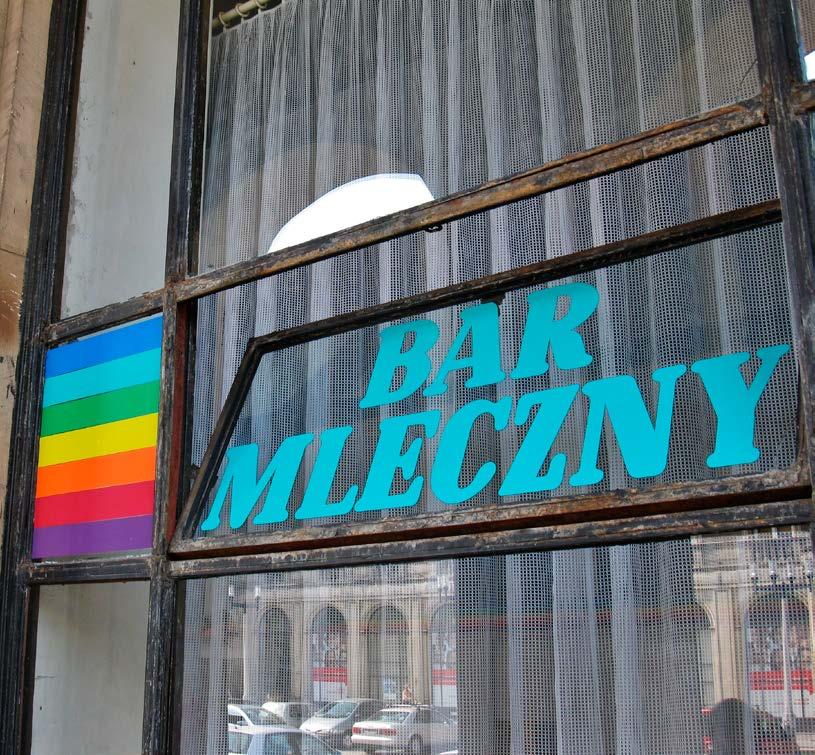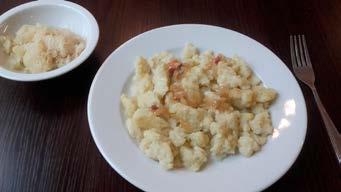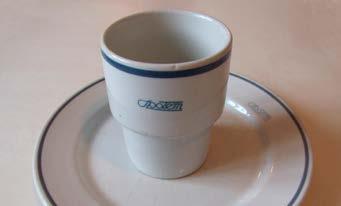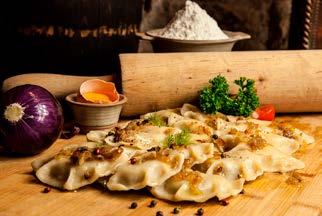
5 minute read
Polish Milk Bars

Polish Milk Bars
Advertisement
The communists’ take on fast food, these nostalgic establishments are living museums of gastronomy in the People’s Republic of Poland.
What, drinking dens for infants? Not quite. Essentially the inverse of gourmet dining, Polish milk bars (bary mleczne) were the communist party’s solution for how to feed the masses, and a visit to one of these working class cafeterias today provides a rare insight into Eastern Bloc Poland.
The concept, though strongly connected to the People’s Republic, actually dates back to the turn of the century; specifically, to a certain Stanisław Dłużewski, a dairy farmer and member of the Polish gentry, who opened the “Nadświdrzańska Dairy” in 1896 Warsaw. Serving simple, milk-based breakfast and lunch items - cocoa, coffee, cheese, baked goods, pierogi, groats with soured milk, potatoes with kefir - he wooed urban workers and the more leisurely, artistic class, and other entrepreneurs followed suit, popularizing the dairy bar idea.
Fast forward to the post-WWII years - what with the new communist regime and general scarcity, the idea of simple, cheap eateries for the proletaryat was perfectly in line with the reigning ideology. Meant to provide hot food for workers who lacked canteens at their place of employment, milk bars provided many other benefits to the communist state, from freeing up women - traditionally responsible for cooking - to work outside the home, to an efficient distribution of whatever food was currently available in the shortage economy, to controlling one more aspect of citizens’ lives. And, of course, it was yet another thing to do communally. With fancy restaurants gone (too bourgeois), milk bars now fed everyone, factory workers rubbing shoulders with university professors and even government officials.
Broadly speaking, the food was sub-par, the staff grumpy, and the crockery chipped and needing a thorough scrub. For a period of time, the menu was even determined by the government, which meant the same bland dishes - with flour and dairy taking centre stage, and meat only sometimes making a brief cameo - served at all milk bars. The bars were strictly self-serve and usually followed the same scheme: patrons would queue up to the cashier, choose the dishes they wanted (each meal component, from cabbage to potatoes, had its own price), then surrender their receipt to a seemingly disembodied hand extending from an opening in the wall, which would in return issue a sloppily loaded plate.

With the collapse of communism most milk bars went bankrupt or transformed into more western-style establishments, but some managed to retain a loyal customer base of pensioners, university students, and cheapskates. Kept alive by state subsidies, which help the prices stay low and impressively random-looking (who needs rounding?), these feed museums are an essential experience for anyone interested in the history of the People’s Republic, or just looking for a very cheap meal.
That being said, ordering milk bar food can be intimidating if you’re a foreigner. English is unlikely to be spoken, the grumpiness has carried over from communist times, and the menu is usually a cluttered letterboard and sometimes an unintelligible mess. Some combination of pointing, scribbling, and pantomime might be necessary, but luckily we’re here to help. Our box on the previous page lists the most common Polish dishes, many of which will be available; other words which you might encounter include the following:

A typical menu board.
Photo by Mohylek, CC BY-SA 3.0
In Polish
ziemniaki, kapusta, buraczki, pomidorowa, fasolka, naleśniki, krokiety, ryba, kluski, kluchy, or kopytka, schabowy, kompot, flaki or flaczki, kaszanka
In English
potatoes, cabbage, shredded beets, tomato soup, beans, crepes, croquettes, fish, dumplings without filling, schnitzel, a boiled fruit drink, tripe stew, blood sausage
After ordering, you can sit down; your order will most likely be called when ready. The experience concludes with taking the dishes back to a window in the wall or to a designated table after you’re done eating, lest you invoke the wrath of the babcia in charge.
Below we list the great three survivors which still exist in the centre of Poznań. Go, and dine like it’s 1967 (and you’re stuck behind the Iron Curtain).

Grey dumplings with cabbage at Przysmak.
POD ARKADAMI
Dating back to the 1970s, this small bar is still going strong, perhaps partially due to branching out into fried chicken. The specialty, though, is regional grey dumplings with cabbage.Q G‑7, Pl. Ratajskiego 10, tel. (+48) 61 852 22 98. Open 11:00-17:00.
PRZYSMAK
Calling this milk bar ‘the Delicacy’ was undoubtedly an act of overconfidence, but its enduring popularity is nothing to scoff at. The ground floor is occupied by a very retro cafe and confectionary; head upstairs to get to the actual bar mleczny.Q H‑7, ul. Podgórna 2, tel. (+48) 61 852 13 39. Open 12:00-17:00.
BAR CARITAS
Run by the charity Caritas, this appears to be the mostforeigner friendly milk bar, advertising their budget meals in three languages. Crepes and fish are the pride of the kitchen.Q H‑7, Pl. Wolności 1, tel. (+48) 61 852 51 30, www.caritaspoznan.pl. Open 08:00-19:00; Sat 10:0018:00; Sun 12:00-17:00. €.

Vintage crockery, once commonly used in milk bars.
Photo by Mohylek, CC BY-SA 3.0
Those wanting to take a quick foxtrot through the world of the Polish kitchen should consider putting the following to the test

Pierogi
Bigos
Also known as Hunter’s Stew. Though there’s no standard recipe for this hearty dish, it’s usually made using meat, cabbage, onions, sauerkraut and whatever else is around, and then left to simmer for a few days. If you have second helpings then consider yourself a Pole by default.
Gołąbki
Translating to ‘little pigeons,’ this favourite dish consists of boiled cabbage leaves stuffed with beef, onion and rice before being baked and served with a tomato or mushroom sauce.
Golonka
Pork knuckle, as in pig’s thigh. A true Polish delicacy, the meat should slip right off the bone, be served with horseradish, and washed down with beer. Go caveman.
Kiełbasa
Sausages, and in Polish shops you’ll find an enormous variety, made from everything from turkey to bison.
Pierogi
Doughy dumplings traditionally filled with potato (Ruskie), sweet cheese, meat, mushrooms and cabbage, or fruit, though if you nose around you will find plenty of maverick fillings like broccoli, chocolate or liver; the possibilities are truly limitless and they are served almost everywhere.
Placki ziemniaczane
These greasy potato pancakes are very similar to Jewish latkes and best enjoyed with goulash on top (placki po węgiersku). Highly caloric, they’re also a tried and true hangover cure.
Zupa (Soup)
Poland has two signature soups: barszcz and żurek. A nourishing beetroot soup, barszcz (aka borscht) may be served with potatoes or mini-pierogi floating in it, or with a croquette for dunking. Żurek is a unique sour rye soup with sausage, potatoes and occasionally egg chucked in, and sometimes served in a bread bowl.

